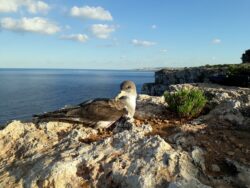Light pollution is a major and growing threat for breeding Yelkouan Shearwater (Garnija), Scopoli’s Shearwater (Ċiefa) and Mediterranean Storm-petrel (Kanġu ta’ Filfla) in the Maltese Islands.

It’s the fledging season for Scopoli’s Shearwaters (Ċief) and light pollution disorientates these young seabirds, leading them to become stranded on land (Photo by Benjamin Metzger)
Artificial light at night is a powerful disruptive force capable of influencing the behaviour of both adults and fledgling birds, altering their behaviour around breeding colonies or on their maiden flights, respectively.
Over the years we have helped to minimize the impacts of light pollution on this very peculiar bird family. BirdLife Malta is once again appealing to the public to look out for any such seabirds which often end up grounded in urban areas, at times kilometers away from the coast.
Coastal light pollution is an issue which affects seabirds
At the moment Scopoli’s Shearwater juveniles are leaving their nests. Light pollution is disrupting the behaviour of adult breeding seabirds and, moreover, causing young birds to become disorientated when they are taking their first flight to the sea. This leads to these birds to become stranded inland in roads, seafronts, ports, towns and other urbanized areas when fledging for the first time.
Places like Ħal Far, Pembroke, Birżebbuġa, Ċirkewwa and Qawra in Malta, together with Xlendi and Mġarr in Gozo, are the most common grounding hotspots for these young seabirds, although during the second half of October they could turn up in almost in any location by the coast. When these birds end up stranded on land, they are unable to fly back out to sea – where they spend the majority of their lives – putting their survival in danger.
This is why whilst we continue working with the authorities to tackle coastal light pollution, every October we also call on the general public to look out for stranded shearwaters and report such cases. Where possible, stranded birds should be collected and gently placed in a cardboard box. The birds should not be given any food or water but kept in a quiet place until they are retrieved by BirdLife Malta staff to be safely released back at sea.
How to identify a Scopoli’s Shearwater (Calonectris diomedea, Ċiefa)
1. Large-sized seabird: about 50cm long, with a wingspan of around 115cm
2. Bulky yellowish beak, hooked at the end
3. Greyish upperparts and dark wings
4. White underparts.
Current threats to this species result mainly from:
1. Introduction of predators in breeding areas
2. Loss of habitat resulting from urban expansion
3. Light pollution that leads to disorientation of juveniles
4. Accidental capture in fishing gear.
Can we count on you?
Be aware and, if you find a bird, collect it carefully and contact us.
- Record the location where you found the bird
- Approach the bird from behind. Pick up the bird using a clean cloth or towel, controlling the head, and holding the wings against the body
- Place the bird in a well-ventilated cardboard box. Keep the box in a cool dark place
- Do not attempt to feed the bird
- Call BirdLife Malta on 2134 7645/6 (office hours)/7925 5697 (evenings and weekends) or the police on 119 in the first instance.
Birds recovered will be looked at by a government vet and taken into a rehabilitation programme. Once they are back to full health, they are released at safe locations at sea by BirdLife Malta staff.
Find out more on how BirdLife Malta is helping seabirds through the LIFE PanPuffinus! project – a multinational effort to improve the conservation status of different shearwater species along with our partners in France, Spain, Portugal and Greece. Visit the project webpage for more details: http://bit.ly/LIFEPanPuffinus.
By Rita Matos, LIFE PanPuffinus! Project Warden


